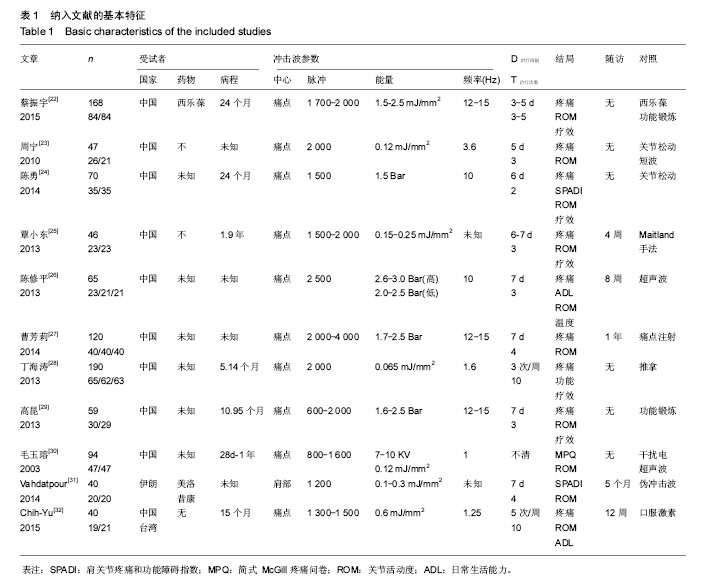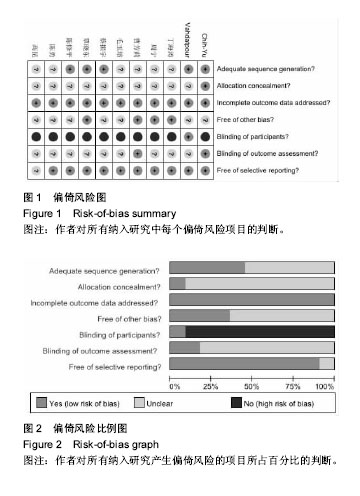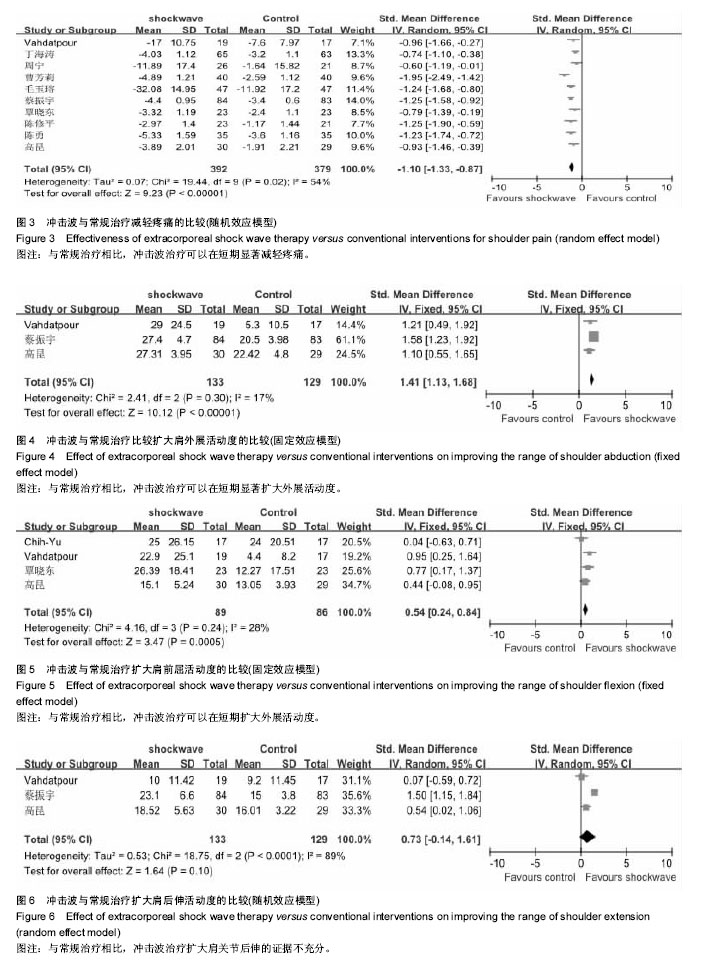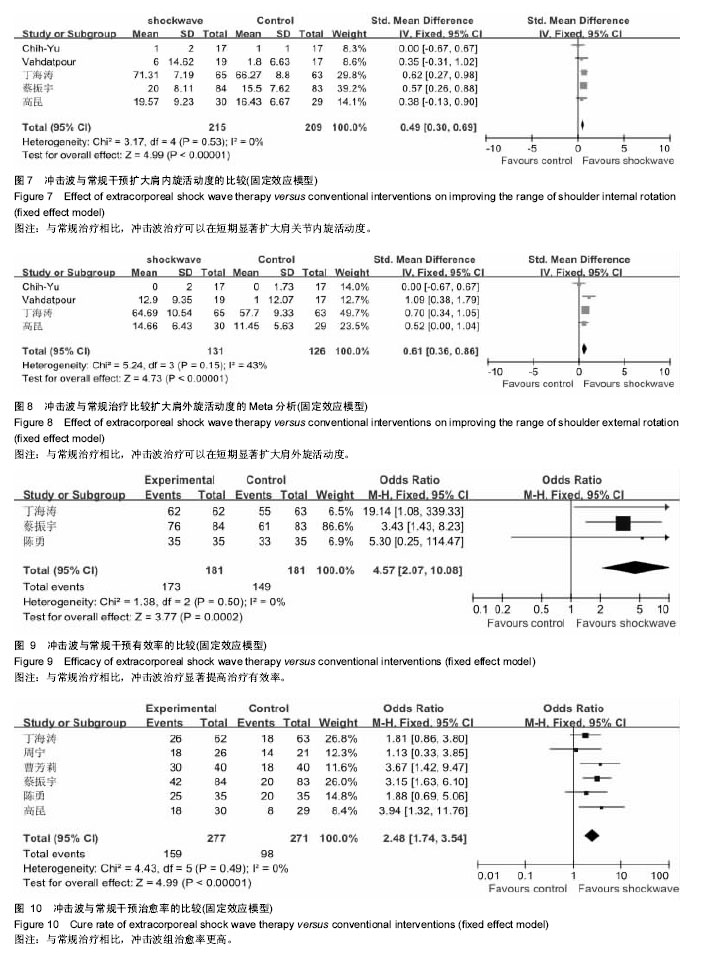| [1] 中华医学会.临床诊疗指南物理医学与康复分册[M].北京:人民卫生出版社,2005:68-69.[2] 王玉龙,高晓平,张秀花,等. 康复功能评定学[M].北京:人民卫生出版社,2013:328-329.[3] 黄晓琳,燕铁斌,王宁华,等.康复医学[M].北京:人民卫生出版社, 2013:215-216.[4] Padua R, Bondi R, Ceccarelli E, et al. Extracorporeal shock wave therapy for chronic calcifying tendinitis of the shoulder. J Orthop Traumatol.2002;2(3):147-150.[5] Gerdesmeyer L,Mittermayr R,Fuerst M,et al.Current evidence of extracorporeal shock wave therapy in chronic Achilles tendinopathy. Int J Surg.2015;24(Pt B): 154-159.[6] Huisstede BM, Gebremariam L,van der Sande R,et al.Evidence for effectiveness of Extracorporal Shock-Wave Therapy (ESWT) to treat calcific and non-calcific rotator cuff tendinosis--a systematic review. Man Ther, 2011;16(5): 419-433.[7] Harniman E, Carette S, Kennedy C, et al. Extracorporeal shock wave therapy for calcific and noncalcific tendonitis of the rotator cuff: a systematic review. J Hand Ther.2004;(2), 17: 132-151.[8] Schmitt J, Haake M, Tosch A, et al. Low-energy extracorporeal shock-wave treatment (ESWT) for tendinitis of the supraspinatus. A prospective, randomised study. J Bone Joint Surg Br.2001;83(6): 873-876.[9] Gross MW, Sattler A, Haake M, et al. The effectiveness of radiation treatment in comparison with extracorporeal shockwave therapy (ESWT) in supraspinatus tendon syndrome. Strahlenther Onkol.2002;178(6): 314-320.[10] Spacca G, Necozione S, Cacchio A. Radial shock wave therapy for lateral epicondylitis: a prospective randomised controlled single-blind study. Eura Medicophys.2005;41(1): 17-25.[11] Ilieva EM, Minchev RM, Petrova NS. Radial shock wave therapy in patients with lateral epicondylitis. Folia Med (Plovdiv).2012; 54(3): 35-41.[12] Reza Mafi, Sandip Hindocha, Wasim S Khan. Recent Surgical and Medical Advances in the Treatment of Dupuytren's Disease - A Systematic Review of the Literature.Open Orthop J.2012;6: 77-82.[13] Knobloch K, Vogt PM. High-energy focussed extracorporeal shockwave therapy reduces pain in plantar fibromatosis (Ledderhose's disease). BMC Res Notes. 2012;5: 542.[14] Alkhawashki HM. Shock wave therapy of fracture nonunion. Injury.2015;46: 2248-2252.[15] Bannuru RR,Flavin NE,Vaysbrot E,et al.High-energy extracorporeal shock-wave therapy for treating chronic calcific tendinitis of the shoulder: a systematic review. Ann Intern Med.2014;160(8): 542-549.[16] 杨克虎.系统评价指导手册[M].北京:人民卫生出版社, 2010: 149-163.[17] 刘鸣.系统评价、Meta-分析设计与实施方法[M].北京:人民卫生出版社,2011.69-127.[18] Roach KE, Budiman-Mak E, Songsiridej N, et al. Development of a shoulder pain and disability index. Arthritis Care Res.1991;4(4):143-149.[19] 谭冠先.疼痛诊疗学[M] .北京:人民卫生出版社,2005: 7-9.[20] 国家中医药管理局.中医病证诊断疗效标准[M]. 南京:南京大学出版社,1994: 200.[21] 陈雯,阳芸.运动疗法结合推拿治疗对疼痛性肩关节挛缩症患者肩关节功能的影响[J].中华物理医学与康复杂志,2012,34(1):76-77.[22] 蔡振宇,林山.体外冲击波治疗疼痛性肩关节挛缩症临床效果观察[J].中国骨科临床与基础研究杂志,2015,7(3):157-161.[23] 周宁,邵彬,陈勇,等.体外冲击波与关节松动术加短波透热治疗疼痛性肩关节挛缩症的效果比较研究[J].中华物理医学与康复杂志, 2010,32(1):38-40.[24] 陈勇,彭轩,汤智伟,等.关节松动术结合体外冲击波治疗疼痛性肩关节挛缩症的疗效观察[J].中国康复,2014,29(3):192-194.[25] 覃小东,曹贤畅,符俏,等.放散状体外冲击波结合Maitland手法治疗疼痛性肩关节挛缩症的疗效观察[J].中华物理医学与康复杂志, 2013,35(7):571-572.[26] 陈修平,夏长所,杨志杰,等.放散式体外冲击波与超声波治疗疼痛性肩关节挛缩症的比较[J].中华实验外科杂志,2013,30(3):636-639.[27] 曹芳莉,郭晓丽,王伍超,等.体外冲击波联合痛点注射治疗疼痛性肩关节挛缩症的临床评价[J].中国疼痛医学杂志,2014, 20(10): 722-724.[28] 丁海涛,唐学章,贾云芳,等.冲击波联合推拿治疗疼痛性肩关节挛缩症的临床疗效观察[J].中国康复医学杂志,2013,28(5):468-470.[29] 高昆,朱喜春,岳立辉,等.体外冲击波配合功能锻炼治疗疼痛性肩关节挛缩症的疗效观察[J].中国骨伤,2013,26(5):401-403.[30] 毛玉瑢,黄东锋,丁建新,等.体外冲击波疗法治疗肩关节周围炎的即时效果分析[J].中国临床康复,2003,7(23):3216-3217.[31] Vahdatpour B, Taheri P, Zade AZ, et al. Efficacy of extracorporeal shockwave therapy in frozen shoulder. Int J Prev Med.2014;5(7): 875-881.[32] Chen CY, Hu CC, Weng PW, et al. Extracorporeal shockwave therapy improves short-term functional outcomes of shoulder adhesive capsulitis. J Shoulder Elbow Surg.2014;23(12): 1843-1851. |
.jpg)





.jpg)